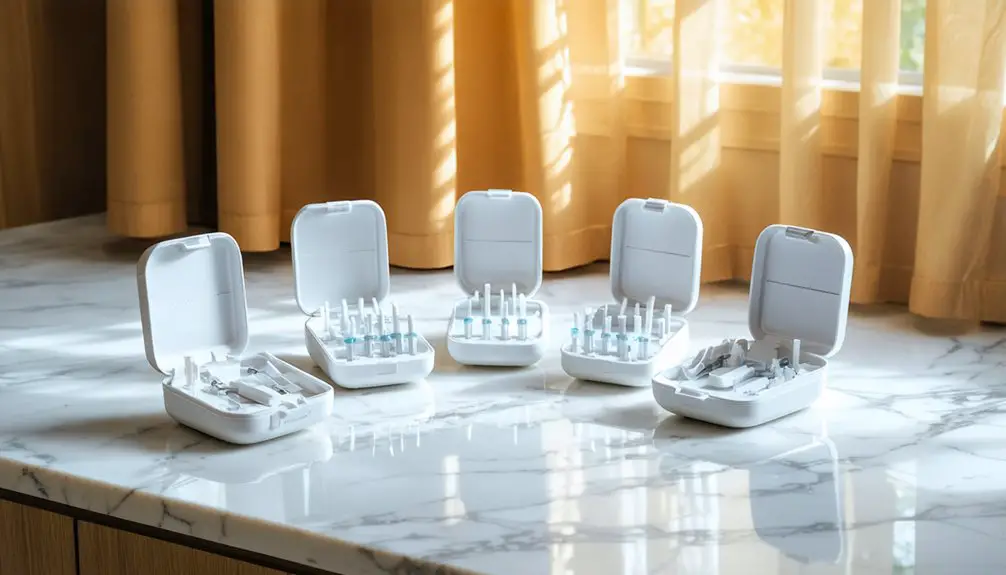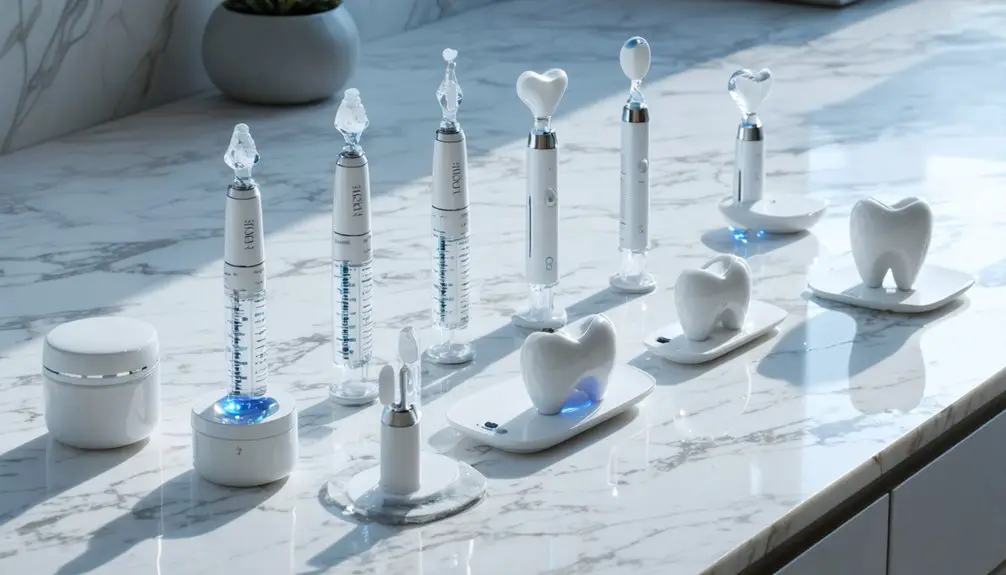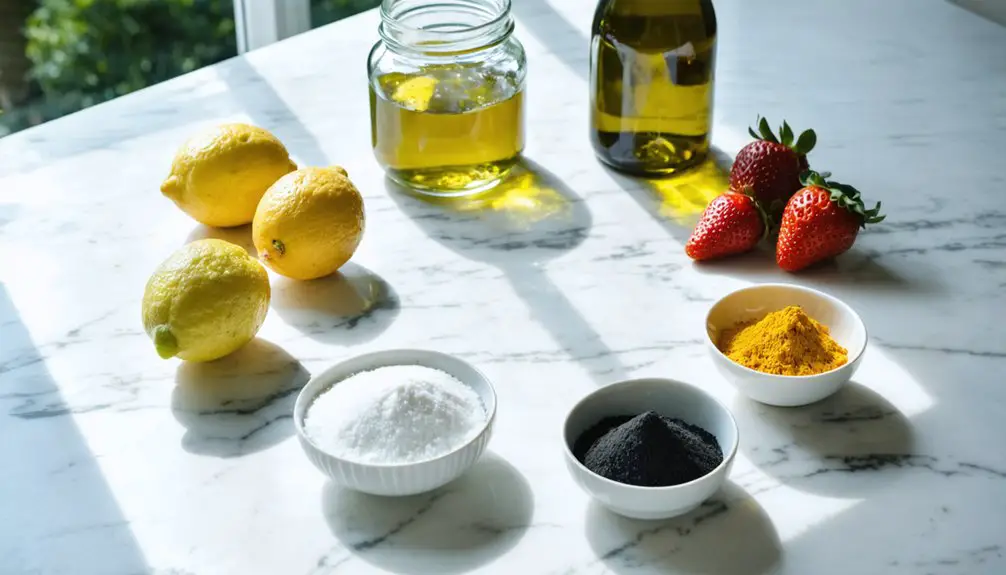You’ll find several proven enamel-safe teeth whitening kits for home use, including Oralgen NuPearl, Crest 3D Whitestrips, Snow Teeth Whitening, and Smile Brilliant. These products use controlled concentrations of hydrogen peroxide (3-10%) or carbamide peroxide, along with protective ingredients to prevent sensitivity. For best results, look for ADA-approved products with clear concentration information and custom-fitted trays. Understanding the science behind enamel-safe whitening can help you make an informed choice.
Key Takeaways
- Crest 3D Whitestrips use controlled peroxide levels and are ADA-approved for safe at-home teeth whitening without damaging enamel.
- Oralgen NuPearl system employs gentle PAP+ technology to whiten teeth by 2.1 shades while preserving enamel integrity.
- Snow Teeth Whitening combines LED technology with soothing agents and moderate peroxide concentrations for enamel-safe results.
- Smile Brilliant’s custom-fitted trays ensure precise application of whitening gel, minimizing contact with gums and protecting enamel.
- GLO Brilliant uses LED technology and controlled peroxide levels to whiten teeth while preventing enamel demineralization.
Understanding Enamel-Safe Whitening Ingredients
While teeth whitening has become increasingly popular, understanding the active ingredients in whitening products is essential for protecting your enamel.
The safest and most effective whitening agents are hydrogen peroxide and carbamide peroxide, which break down stains without damaging tooth structure when used at appropriate concentrations. Products lacking clear concentration information should be avoided to prevent potential enamel damage. Consulting a dental professional beforehand helps monitor your tooth health during whitening treatment.
For ideal enamel preservation, look for products containing 3-10% hydrogen peroxide or its carbamide peroxide equivalent. Higher concentrations should only be used under professional supervision.
Avoid whitening products with harsh abrasives like baking soda or acidic ingredients such as lemon juice, which can erode enamel over time.
Instead, choose formulations that combine peroxide with fluoride and gentle cleaning agents. These combinations provide effective whitening while maintaining your enamel’s integrity through controlled peroxide concentration and exposure time.
Key Features of Gentle Teeth Whitening Products
When selecting gentle teeth whitening products, several key features distinguish enamel-safe options from potentially harmful alternatives.
Modern whitening kits prioritize user friendly design and comfort features that protect your dental health while delivering effective results. The PAP+ technology used in advanced formulas ensures a completely sensitivity-free experience while effectively removing stains. Using products with 6% hydrogen peroxide offers an effective yet gentle approach for those with sensitive teeth. Look for products incorporating advanced delivery systems and specialized formulations that minimize sensitivity.
Today’s teeth whitening solutions focus on gentle, effective formulas that brighten your smile while keeping your dental health intact.
- Light-activated gels paired with LED devices reduce chemical contact time while maintaining effectiveness.
- pH-balanced formulas with non-peroxide agents like PAP protect enamel integrity.
- Gradual treatment programs (8-12 days) allow teeth to acclimate and prevent overexposure.
- Customized mouth trays and strips guarantee even application distribution to avoid concentrated exposure.
These features work together to provide gentle whitening while safeguarding your enamel’s long-term health, typically achieving 1-3 shade improvements without compromising dental wellness.
Top-Rated Whitening Kits That Protect Your Enamel
Several leading teeth whitening kits combine effective bleaching power with advanced enamel protection features.
The Oralgen NuPearl system uses phthalimidoperoxycaproic acid to lighten teeth by 2.1 shades while minimizing sensitivity. Clinical tests showed 100% of testers found it gentle on teeth and gums during use.
Crest 3D Whitestrips offer controlled peroxide levels and prolonged contact for maximum home whitening effectiveness. Professional dentists recommend spacing treatments 48 to 72 hours apart to protect enamel health.
For enhanced enamel protection methods, Snow Teeth Whitening and GLO Brilliant incorporate LED technology with soothing agents like potassium nitrate and fluoride.
Smile Brilliant’s custom-fitted trays guarantee precise gel application, reducing the risk of enamel damage.
These systems typically use moderate peroxide concentrations (10-35% carbamide peroxide or 3-10% hydrogen peroxide) and include ingredients that help prevent demineralization during treatment.
LED activation allows for accelerated whitening at lower peroxide levels, preserving your enamel’s integrity.
Best Practices for Safe At-Home Teeth Whitening
Proper technique and consistent habits are essential for achieving safe, effective results with at-home teeth whitening. When using whitening products, you’ll need to follow manufacturer instructions precisely to protect your enamel and avoid sensitivity. The oxidation process helps break down stain molecules to restore your natural tooth color. Light-activated gels are best left to professional dental offices for safer application.
For natural whitening and enamel protection, incorporate a thorough approach that combines gentle methods with protective measures.
- Always consult your dentist before starting any whitening regimen to guarantee your teeth and gums are healthy enough for treatment.
- Use ADA-approved products containing controlled concentrations of hydrogen peroxide or carbamide peroxide for safe stain removal.
- Limit baking soda treatments to once or twice weekly, and never use abrasive ingredients without proper dilution.
- Support your whitening efforts with calcium-rich foods and proper hydration while avoiding staining beverages and tobacco products.
Preventing Enamel Damage During Whitening Treatment
When using whitening treatments, you’ll need to carefully follow application instructions to minimize potential enamel damage and sensitivity. Since enamel cannot repair itself, it’s critical to choose whitening-safe products that won’t cause permanent harm.
You should avoid harsh abrasives and acidic products that can erode your enamel, opting instead for gentle formulations containing fluoride. Consulting with dental professionals first helps ensure safe and effective treatment that won’t compromise your enamel integrity.
After treatment, protect your teeth by using remineralizing products and temporarily avoiding staining foods and beverages while your enamel recovers.
Proper Application Methods
Protecting your tooth enamel during whitening treatment starts with precise application methods that minimize exposure risks. When selecting whitening products, prioritize those with lower peroxide concentrations and custom-fitted trays to prevent gel leakage. Proper application techniques will help you achieve peak results while safeguarding your dental health.
- Follow manufacturer’s instructions carefully, never exceeding recommended treatment times or frequency of use.
- Use custom-fitted trays or professionally designed strips that provide even coverage without excess product contact.
- Apply whitening gel sparingly to avoid overflow, and remove any excess that contacts your gums.
- Monitor your teeth for sensitivity during treatment and adjust application time or frequency accordingly.
Always consult your dentist before starting any whitening regimen to verify your chosen product and application method are appropriate for your dental needs.
Protective Post-Treatment Care
After completing your teeth whitening treatment, strategic post-care measures become essential to safeguard your enamel and maintain results.
Focus on enamel remineralization by applying fluoride treatments and using calcium phosphate products to restore mineral content. You’ll need to avoid acidic foods and beverages for 48 hours while maintaining proper post-treatment hydration to support natural saliva production.
Don’t brush immediately after treatment, and when you do, use a soft-bristled toothbrush. Choose desensitizing toothpaste with potassium nitrate to minimize nerve irritation.
Chew sugar-free gum to stimulate protective saliva flow, and consider professional remineralizing treatments for best results.
Remember to space out future whitening sessions appropriately, allowing sufficient recovery time between treatments to prevent cumulative enamel damage.
Proven Results With Enamel-Safe Whitening Methods
Research confirms that enamel-safe teeth whitening methods can deliver significant results without compromising tooth structure when properly administered.
Modern teeth whitening methods offer proven effectiveness while keeping tooth enamel intact through proper application techniques and controlled formulations.
You’ll find both professional treatments and home remedies that effectively whiten teeth while maintaining enamel integrity. Natural alternatives like bromelain offer particularly gentle yet effective whitening action without cytotoxic effects.
- Opalescence™ systems provide controlled-release peroxide formulations proven safe for at-home and professional use.
- Light-activated office treatments with 35% hydrogen peroxide penetrate effectively while minimizing surface effects.
- Whitening strips containing 6.5% hydrogen peroxide demonstrate safety when used as directed.
- Natural enzyme-based products featuring bromelain achieve stain removal without observable enamel changes.
These evidence-based options deliver reliable results while prioritizing your enamel’s long-term health, making them suitable choices for both professionals and patients seeking safe whitening solutions.
Expert-Recommended Products for Sensitive Teeth

If you’re seeking gentler alternatives to LED whitening systems, several clinically-proven options can effectively brighten your smile without heightened sensitivity.
You’ll find dentist-recommended products like Oral Essentials Lumineux and Crest 3D Whitestrips Gentle Routine that use lower concentrations of peroxide or natural ingredients.
These daily solutions offer gradual whitening while protecting your enamel through controlled application methods and sensitivity-reducing compounds.
LED-Free Gentle Options
For individuals with sensitive teeth seeking gentler whitening solutions, LED-free options provide effective results without the potential irritation caused by light activation.
These LED alternatives focus on sensitivity management through carefully formulated chemical agents or natural compounds that work gradually to brighten your smile.
- TrueWhite Whitening Pen offers portable, gentle application without LED activation, making it ideal for sensitive teeth.
- Chemical whitening agents in lower concentrations minimize enamel impact while still delivering noticeable results.
- Natural compounds work more slowly but provide reliable whitening without the risks of light-induced sensitivity.
- Extended application times are necessary compared to LED systems, but the gentler approach better preserves enamel integrity.
While these methods may require more patience, they’re specifically designed to protect vulnerable teeth while achieving desired whitening results.
Dentist-Trusted Daily Solutions
Dentists consistently recommend several proven daily solutions that protect sensitive teeth while delivering effective whitening results.
For daily use, Sensodyne Whitening toothpaste combines gentle whitening agents with potassium nitrate to soothe nerve endings while maintaining enamel integrity. Custom-fitted trays from your dentist allow precise control of whitening gel concentration and application time, minimizing sensitivity risks.
For at-home treatments, look for products bearing the ADA seal that contain lower peroxide concentrations (6-10% hydrogen peroxide or 10-35% carbamide peroxide).
Crest 3D White Whitestrips Gentle Routine and GLO Science kits offer clinically-backed formulations specifically designed for sensitive teeth.
These dentist recommendations emphasize using products that gradually whiten while building protective layers over your enamel, ensuring safe, lasting results.
Frequently Asked Questions
Can I Whiten My Teeth if I Have Dental Crowns or Veneers?
You can whiten your natural teeth, but teeth whitening options won’t change your crowns or veneers’ color. Discuss crown maintenance with your dentist to avoid potential color mismatches between restorations and natural teeth.
How Long Should I Wait Between Professional Cleaning and Starting Home Whitening?
Like a gladiator resting after battle, you’ll want to wait 24-48 hours minimum after your professional cleaning before starting whitening. For best results and reduced sensitivity, consider extending this to 1-2 weeks.
Is It Safe to Whiten Teeth While Pregnant or Breastfeeding?
You shouldn’t whiten your teeth during pregnancy due to safety concerns and limited research. If you’re breastfeeding, consult your dentist first. Consider alternative methods like professional cleaning and dietary changes instead.
Will Whitening Kits Affect the Bonding Material Used in Dental Fillings?
Yes, whitening ingredients can weaken your dental bonding materials over time. You’ll want to consult your dentist before whitening if you have fillings, as results may be uneven between natural teeth and restorations.
Can Teenagers Safely Use At-Home Teeth Whitening Products?
Like a young sapling needing proper care, your teenage dental health requires supervision. You’ll need a dentist’s approval before using safe whitening options to protect your developing teeth.
References
- https://shopismile.com/products/deluxe-home-teeth-whitening-system
- https://www.goodhousekeeping.com/health-products/g28723133/best-at-home-teeth-whitening-products/
- https://www.goodrx.com/conditions/dental-care/is-teeth-whitening-safe
- https://www.target.com/c/best-teeth-whitening/enamel-safe/-/N-bxg5wZ7v4ay
- https://www.elevatedentalmo.com/post/teeth-whitening-is-it-safe-on-tooth-enamel
- https://bellevuedentaloasis.com/blog/teeth-whitening-ingredients-to-avoid/
- https://www.medicalnewstoday.com/articles/326148
- https://crest.com/en-us/oral-care-products/toothpaste/crest-3d-white-professional-ultra-white-toothpaste-3-0oz
- https://gloscience.com/blogs/blog/before-it-goes-in-your-mouth-check-your-ingredients
- https://be-lucent.com/products/stellar



